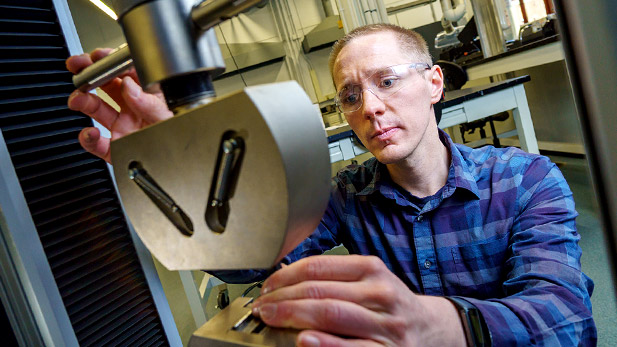Professor Matt Riley and Students Work on NASA Lunar Energy Project

Associate Professor of Mechanical Engineering Matt Riley, Ph.D. works with Rose students on a NASA project to design a flywheel that creates energy storage for future manned missions to the Moon.
Successfully colonizing on the Moon may sound like a work of science fiction. But in today’s world, it’s a goal that’s more within reach than not. Scientists are working with NASA on various components to make Moon occupation a reality. Associate Professor of Mechanical Engineering Matt Riley, Ph.D., is one of those individuals. Riley works with Rose students on a NASA project to design a flywheel that creates energy storage for future manned missions to the Moon.
Like life on Earth, a lunar colony needs to generate energy to survive. Yet the two most viable energy options — solar and nuclear — have limitations because of the Moon’s location in its 28-day cycle. For 14 days, the Moon is in the direct path of the Sun, giving one side of the planet 14 days of daylight. The other 14 days without sunlight are essentially night. Solar energy can be generated in the 14 days of sunlight and nuclear energy can be generated in the 14 days of darkness. But both options leave a 14-day gap in energy production. This is where the flywheel comes into play.
A flywheel is a mechanical device that uses kinetic momentum to store rotational energy. Flywheels are 1,000 times more efficient per unit mass than batteries and can create more energy given their speed. The idea behind Riley’s project is to build a flywheel that harnesses enough solar energy in its 14 days of sunlight to store for the remaining cycle.
“If you double the speed of flywheel, you take energy up by factor of four,” said Riley. “So instead of making big flywheels, we make them really fast, like 100,000 RPM.”
The flywheels are 14 to 18 inches in diameter, one-foot tall and weigh 20 to 30 pounds. The outer ring is spinning incredibly fast, at 7-times the speed of sound. The challenge is making it spin safely at a high enough speed to generate energy.
“In order to make the flywheel work effectively, for something to spin that fast, you can’t have it hold onto something else because the friction will use too much energy,” said Riley. “Controlling that without actually touching it is a novel concept, especially in a low-gravity environment. … There are also safety concerns. The flywheel is essentially spinning at a speed that has the same amount of kinetic energy as 63 pounds of TNT.”
Riley began working on the project when he was an assistant professor at University of Idaho. Along with faculty in electrical engineering and physics, Riley applied for a NASA grant to explore the potential of colonization and how energy could be managed on the Moon. His team created a flywheel proof of concept for NASA. The organization continued to fund the project with a goal of bringing the idea to scale. Riley brought his part of the project to Rose-Hulman when he joined the college in 2016. His portion focuses on the materials and modeling components; how the model is designed and built.
“When you’re spinning something that fast, it naturally wants to expand —think of spinning pizza dough on your finger and how the dough gets bigger,” said Riley. “To keep it in control, we have to keep it within a half a millimeter of how much it expands. There are currently no materials that exist to do that. I’m working with students to use composite materials — iron and small nano and carbon fibers — to give it the strength to spin that fast.”
Thus far, nobody has developed models or equations for what happens when you use more than one material.
While the research and building something for NASA is thrilling, Riley is equally motivated by working with students and exposing them to the research environment. In fact, the intent of the original NASA grant was to expose undergraduates to graduate-level research projects. While Riley has worked with several Rose-Hulman students on the NASA project, Mechanical Engineering alumni Brian Wyatt (2019), Austin Perry (2020) and Grayson Nemets (2022) were the primary student contributors.
“Usually, students don’t experience this type of research until graduate school,” said Riley. “And that works for students that go on to grad school. But for undergraduates who go directly into industry, they don’t have this type of exposure.”
The NASA project is an example of how Rose provides undergraduate research opportunities. Riley and his mechanical engineering students are working to validate the models and use that to build the flywheel. His goal is to have a prototype that can be tested on land within five years.